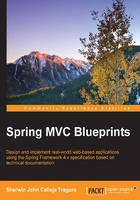
Preface
Many books have been written about Spring Framework that discuss its design patterns and principles, core components, and coding standards and styles, as well as the configuration details of its container, all of which provide a good start to creating a web application. Some literature focuses more on the new features of every release and provides a marketing model for how Spring can help boost the software industry. There are a few that serve as a cookbook of Spring definitions and components for advanced users. Rarely are books written that provide readers with all the core concepts of the Spring specification in collaboration with the most common and popular software libraries, plugins, or frameworks needed to create software with optimal, if not fast, performance, efficient and effective workflows, clever data presentation and business intelligence, standardized graphical user interfaces, and testable, robust, and simple architecture.
This book offers 10 chapters that aim to provide a full guide to maximizing the features of Spring in order to provide technical solutions to some needs from different areas of discipline. It consists of basic concepts about how to start implementing and deploying Spring applications. It provides some new workarounds to Spring users and poses open-ended questions to advanced developers to continue doing research on the Spring 4.x specification.
Writing this book was time consuming since each chapter has its own dedicated software blueprint to be implemented in order to exhibit all the concepts elaborated in the chapters. Not only the results, but also the technical issues and bugs have been taken into consideration to check whether all functional specifications can fit into one project with the correct API library versions available. Due to time constraints, not all software blueprints are as good as finished products yet, but they are fully executable specimens for the book, covering all the details of the Spring 4.x framework.